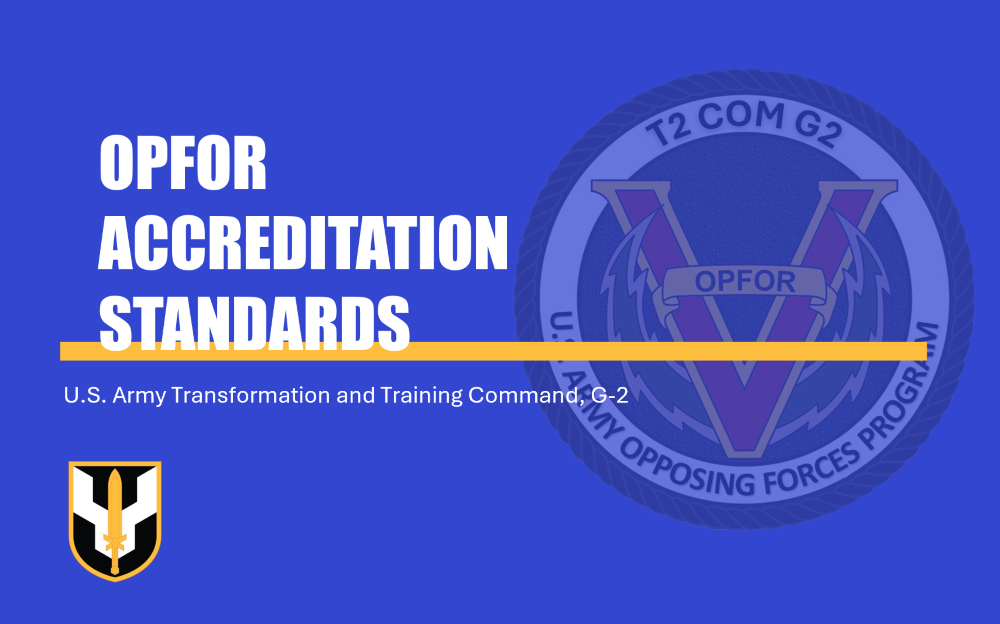OE-OPFOR
Accreditation
WHAT IS OE-OPFOR ACCREDITATION?
To ensure the OE and OPFOR complexities set the appropriate training conditions, maintains credibility as a training aid, and achieves desired training objectives and outcomes, T2COM G2 conducts an accreditation program.
The OE/OPFOR pillar focuses on validating methods for realistic representation of the Operational Environment (OE) and conducting Maneuver Readiness Exercises (MRE's) and DATE-compliant exercises. It employs contemporary OPFOR using technology and asymmetric tactics to support Army-wide training outcomes, unit training objectives, and leader development. The T2COM G2 accredits training and education programs based on set standards and criteria.
Assess compliancy for Collective Training:
Collective training accreditations apply to various training organizations, including CTCs, USAR training divisions, JPMRC, and ARNG collective training programs. These programs use an operational environment (OE) and opposing force (OPFOR) for training purposes.
An interdisciplinary accreditation team of subject matter experts on OE and OPFOR training, and leader development from the Army and Joint community, including OPFOR representatives from other activities, is led by the T2COM G2.
The team visits the training sites, makes observations, and prepares a written report with observations, discussions, and recommendations for the observed commander. The report determines whether the observed operational variable portrayal is accredited or not, based on the extent to which the replication helped the training unit achieve training objectives and desired training outcomes. The T2COM G2 also uses observations and input from training units as a feedback mechanism to improve the OE and OPFOR doctrinal, training, and training materiel development process.
The use of OE and OPFOR standards within collective training venues is accredited to ensure:
- The OPFOR is adequately resourced to replicate the OE and other-directed training.
- Leaders, planners, observer, controller, trainers, OPFOR & role players are trained and knowledgeable about the OE and its impact on military operations.
- Training venues plan, implement, and resource replication of complex and interrelated Operational Variables for the type of exercise and in accordance with senior Army leader directives, exercise director's guidance & rotational training unit commander's training objectives.
- The training venue replicates/executes complexities of the OE within Live, Virtual, Constructive domains for LSCO training exercises or other-directed training.

This accreditation process ensures that the training is consistent with Army and Joint doctrine, relevant and realistic to the current operational environment and potential threats, and that training objectives and outcomes are met.
Assess compliancy for COEs/Schools:

The T2COM G2, a supporting member of the T2COM G2 Quality Assurance Office (QAO), reviews and evaluates the integration of operational environment (OE) and opposing force (OPFOR) in the programs of instruction and classroom instruction within Army and T2COM G2 Centers of Excellence (COEs) and schools. They assess the inclusion of doctrinal OE and OPFOR training in lesson plans and scenarios, review instructor certification programs, and validate student competency in OE and OPFOR characteristics during exercises. The findings are presented to the COE or school commandant as part of the overall QAO accreditation report, which is also forwarded to the T2COM G2 Deputy Commanding General and Chief of Staff.
Engage with OE-opfor Accreditation:

Find out the current disposition of approved OPFOR Accreditation efforts, or request assistance from the OPFOR Accreditation team.


